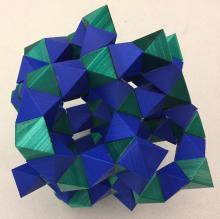Let’s start with some questions, and some tautological answers:
Q. What does a mathematician do?
A. They create mathematics.
Q. What does an artist do?
A. They create art.
The second answer seems more solid—because we feel we know better what it means to create art. The first feels so circular—what does it means to create mathematics? One of the goals of Axiomatic, my recent Simpson Center-supported collaboration with the visual artist Timea Tihanyi, was to help elucidate similarities and differences between the process of creating mathematics and creating art, and to do this by creating art that reflects these processes.
As a mathematician, this collaboration was a uniquely thrilling experience, as it helped me to create and communicate in a way I had never experienced before. Timea and I interviewed mathematicians and artists (including each other) about what they felt was fundamental, or axiomatic, to their chosen field and to their process of creation. Based on our discussions, we started to create objects that reflected common threads in our discussions.
Mathematicians work with patterns—my personal definition of mathematics is that it is the abstract language of systematic pattern recognition. When we, as mathematicians, write our poems, our prose, our plays, in this language, we are usually accessible only to each other. As the English mathematician, G.H. Hardy said, “A mathematician, like a painter or a poet, is a maker of patterns.” For me, the most interesting mathematical patterns come when one object can be seen from a variety of different perspectives; when an object has many incarnations, many interpretations. I think many people feel the same way about art.
The experience of learning another person’s creative process, of collaboration, I feel, is at the heart of the CHID philosophy. Working with Timea, I saw the sweat, the effort, and in one memorable Skype session, the blood that goes into making things. Timea was in residence at the European Center for Ceramics, and was attempting to fire a piece that represented the shadow of a 4-dimensional object in 3-dimensional space. The piece had shattered in the kiln, and when she went to remove it, the shards sliced her hands. I’ve been through much mental anguish while working math but never ended up bleeding!
Some of the pieces that Timea created as part of our project were displayed at a memorable exhibit, 9E2, at the King Street Station, in Autumn 2016, and I will have several of my pieces on display at the Center on Contemporary Art in March 2018. We’d love to see the CHID community there.
By Jayadev Athreya, CHID Affiliate Faculty
